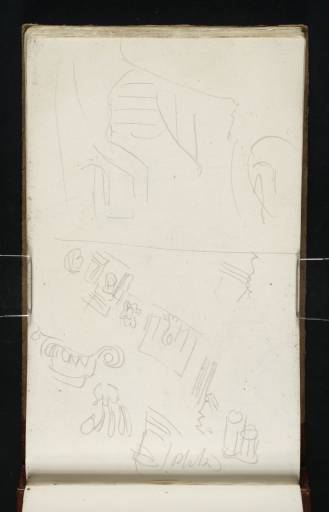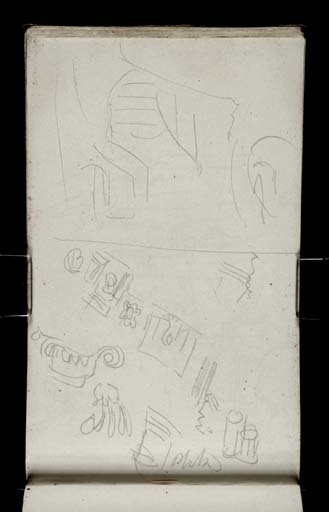Joseph Mallord William Turner Studies at Herculaneum, with Architectural Fragments 1819
Image 1 of 2
Joseph Mallord William Turner,
Studies at Herculaneum, with Architectural Fragments
1819
Joseph Mallord William Turner 1775–1851
Folio 87 Verso:
Studies at Herculaneum, with Architectural Fragments 1819
D15899
Turner Bequest CLXXXV 85 a
Turner Bequest CLXXXV 85 a
Pencil on white wove paper, 189 x 113 mm
Inscribed by the artist in pencil ‘[?Plank]’ within sketch at bottom
Accepted by the nation as part of the Turner Bequest 1856
References
1909
A.J. Finberg, A Complete Inventory of the Drawings of the Turner Bequest, London 1909, vol.I, p.550, as ‘Fragments of capitals, &c.’.
1984
Cecilia Powell, ‘Turner on Classic Ground: His Visits to Central and Southern Italy and Related Paintings and Drawings’, unpublished Ph.D thesis, Courtauld Institute of Art, University of London 1984, pp.187, 491 note 32, 496 note 82.
1987
Cecilia Powell, Turner in the South: Rome, Naples, Florence, New Haven and London 1987, pp.79 note 25, [82]–3 note 64.
As Cecilia Powell has previously discussed, the drawings on folios 80 verso–87 (D15886–D15898; Turner Bequest CLXXXV 78a–85) of this sketchbook relate to Turner’s exploration of the archaeological site at Herculaneum.1 Unlike the extensive ruins at Pompeii, the ancient town had not yet been subject to a sustained period of excavation and there was very little to see beyond the subterranean passages of the theatre. Consequently, Turner’s sketches are very sparse in detail and, by their rough nature, appear to have been executed in the dark.2 This page appears to contain a view of a staircase descending into an underground chamber, as well as several swift studies of architectural fragments including ornamental mouldings, pillars and part of an Ionic capital. The location is almost certainly the theatre, which in 1819 was almost the only structure of note accessible to view. A similar scene was described by Sarah Atkins in her book, Relics of Antiquity, exhibited in the Ruins of Pompeii and Herculaneum, first published 1825:
our passage through the little dark galleries was here and there almost totally obstructed by bricks, tiles and mortar, marble cornices, friezes, and other ornaments, which lay about in endless confusion, together with elegant stuccos, beams, and rafters, blocks and billets for fuel, and even what appear to have been the trees that stood in the town, and large quantities of the earth and lava that overwhelmed the place at the time of its destruction, all mingled and crushed together in such a manner as I cannot pretend to describe.3
For a fuller description of Herculaneum and the theatre see folio 86 (D15896; Turner Bequest CLXXXV 84).
Nicola Moorby
November 2010
How to cite
Nicola Moorby, ‘Studies at Herculaneum, with Architectural Fragments 1819 by Joseph Mallord William Turner’, catalogue entry, November 2010, in David Blayney Brown (ed.), J.M.W. Turner: Sketchbooks, Drawings and Watercolours, Tate Research Publication, December 2012, https://www


